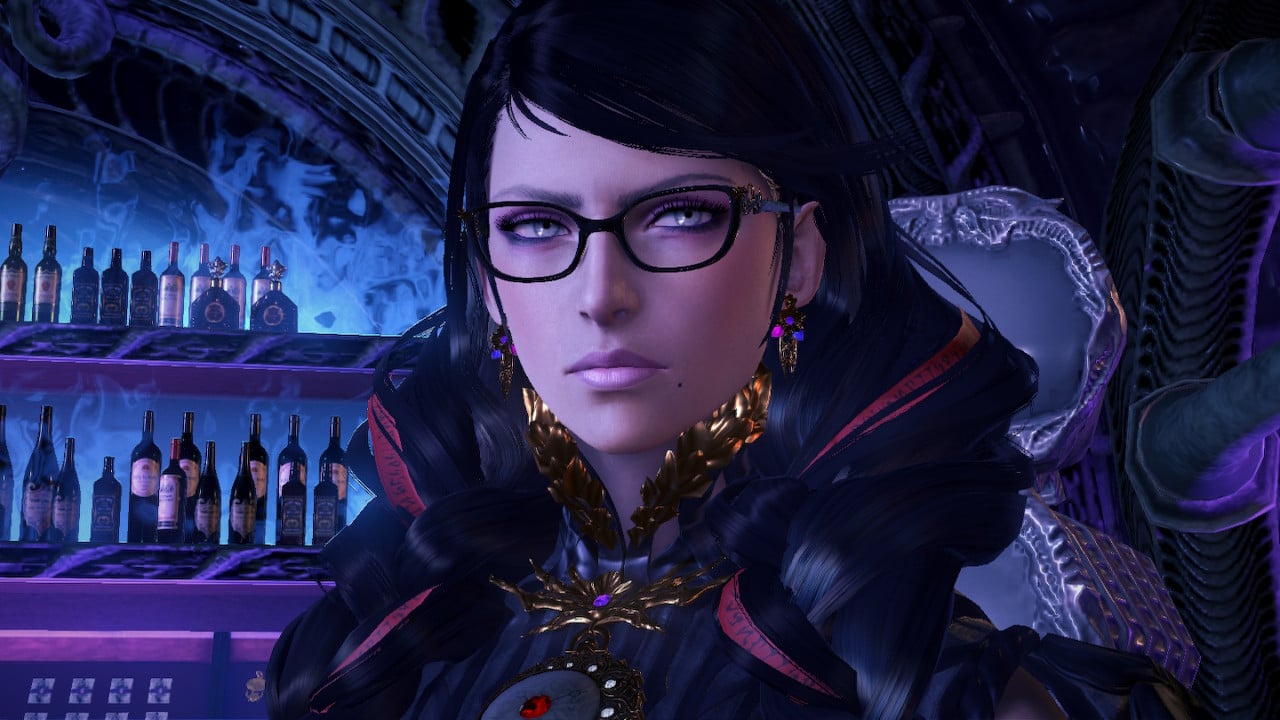
Summary:
Bayonetta’s sharp wit, ballet-like combat, and striking silhouette turned her into a modern icon—but it’s the glasses that tie everything together. Over sixteen years, debate swirled around whether she should wear them, and the answer was a constant no. Hideki Kamiya championed the eyewear from day one, batting away requests to remove them and sharing a now-famous line likening the glasses to something you never take off. Character designer Mari Shimazaki built that conviction into her art process, keeping a dedicated “glasses layer” ready while exploring different directions. Cinematics leadership underscored the same idea: the glasses aren’t a prop; they’re identity. Even a lore nugget—Luka being the only man to ever see Cereza’s bare face in Kamiya’s titles—makes the eyewear feel story-critical rather than cosmetic. What does that choice achieve? Clear silhouette, instant brand recognition, and a confident aesthetic that fuses fashion with ferocity. This piece unpacks the quotes, the design reasoning, and the ripple effects on gameplay readability, marketing, and the character’s long-term legacy.
Bayonetta’s glasses as a non-negotiable identity marker
Signature details are the glue that hold a character together, and Bayonetta’s glasses are the kind of choice you feel before you rationalize it. They sharpen her gaze, frame her expressions, and give every smirk a touch more voltage. When you think about instant-recognition design—Mario’s cap, Samus’s visor, Joker’s mask—Bayonetta’s eyewear belongs in the same club. It’s not just “accessory energy.” The glasses anchor her whole vibe: elegant, in control, and ever so ready to cut an angel down to size. In frantic combat, where camera angles whip and particle effects bloom, that glint across her lenses becomes a steady heartbeat. It sells the character at a glance, keeps the silhouette readable, and makes every pose land with attitude. Remove the glasses and the outline softens; keep them and the outline snaps into place. That’s the difference between a neat idea and an immortal look that sticks with players for years.
Hideki Kamiya’s stance and the now-famous “underwear” comparison
Behind the scenes, there were real conversations about ditching the glasses. Kamiya was unwavering. He pushed back whenever the suggestion came up, and he later shared a line that crystallized the team’s thinking: Bayonetta’s glasses are like something you never remove. Blunt? Sure. Effective? Absolutely. The point wasn’t shock; it was clarity. He wanted everyone—from publishers to partner teams—to understand that this wasn’t a modular part you swap on and off. It was a boundary line for the character’s identity. That kind of conviction is rare, especially when pressure builds to smooth away sharp edges in the name of mass appeal. But sharp edges are where icons live. By holding the line, Kamiya ensured Bayonetta would keep the visual hook that made her feel singular. It’s a small object with big consequences: one persistent detail that sets tone, frames personality, and tells you exactly who’s running this show.
Mari Shimazaki’s sketch process and the “glasses layer” habit
On the art side, Mari Shimazaki treated the glasses as a pillar from the sketch phase onward. She has described how, during rough passes, she kept a dedicated “glasses layer” on standby—ready to toggle as she tested silhouettes, hairstyles, and facial angles. That habit says a lot about how character designers work when they’re chasing the perfect read at a glance. Eyewear changes everything: cheekbones, eye shape, the rhythm between eyebrows and hairline. By iterating with glasses always in the loop, Shimazaki protected the idea from becoming an afterthought. Instead of bolting a pair of frames onto a finished face, she built Bayonetta around the eyewear’s presence, letting it influence posture, poise, and even the temperature of a smile. That’s how you get a design that doesn’t just wear glasses—it lives in them. The result is coherence that survives different costumes, engines, and cameras without losing the spark.
The cinematics angle: why Shimomura doubled down
Action games live and die on how faces read in motion. In cutscenes, those readings get magnified, so cinematics leadership weighed in early and decisively. The message was simple: the glasses are integral to how Bayonetta performs on camera, and they stay on. That decision doesn’t just protect a look; it stabilizes acting beats. Reflective lenses can punctuate a taunt, turn a head tilt into a punchline, or mask a flash of emotion until the exact frame it matters. Think of them as a director’s tool baked into character design. When you commit at that level, everything syncs: lighting rigs plan for lens highlights, animators choreograph micro-glances, and editors learn where to cut so the glint becomes an exclamation mark. The cascaded effect is clean—Bayonetta never looks unfinished or inconsistent between gameplay and cinematics because the same rule applies: the glasses aren’t optional, they’re foundational.
The Luka note: the only man to see Bayonetta’s bare face
Lore nods can feel like fan treats, but sometimes they carry design weight. Kamiya has noted that, in the titles he helmed, the only man who ever saw Bayonetta—Cereza—without her glasses was Luka. That tiny detail adds texture without overwriting the mystery. It’s not about fragility or disguise; it’s about intimacy and trust defined on her terms. For a character built on confidence, that distinction matters. The rule reinforces a recurring theme across her adventures: Bayonetta chooses what to reveal and when, whether it’s a cutting one-liner or the flick of a wrist that becomes a hair-fueled kick. Tying the eyewear to that selective vulnerability turns the glasses into more than a fashion statement. They become a storytelling device. Players may never notice the rule consciously, but they feel it in the way the character holds space—always self-possessed, always controlling the frame.
How eyewear anchors silhouette, readability, and style in action games
In high-speed combat games, clarity is king. Designers obsess over silhouettes because readable shapes let players parse threats and opportunities in milliseconds. Eyewear, oddly enough, can be a huge help. Frames outline the eyes, which are emotional beacons in the middle of chaos. When a combo finishes and the camera snaps for a stylish flourish, those lenses flash like a metronome the brain can latch onto. That flash pairs beautifully with Bayonetta’s long limbs, angular poses, and hair-woven couture. The frames turn big movements into crisp punctuation, the way a conductor’s baton makes a gesture legible from the back row. There’s also a fashion-tech balance at work: the glasses keep her in that sweet spot between theatrical and grounded, as if she could step off the screen and into a runway show without changing a thing. That dual read—mythic yet wearable—explains why the look photographs so well in promos and fan shoots alike.
From Bayonetta 1 to future entries: evolution without losing essence
Great series shift with time, but the best ones protect a heartbeat. Across sequels and spin-offs, Bayonetta’s hairstyle, outfits, and color accents have evolved, yet the eyewear throughline keeps the character instantly recognizable. You can swap a bob for a beehive, trade a velvet sash for a leather ribbon, or introduce a fresh palette to match new locales and lore beats; the glasses pull these variations back into a single identity. That consistency unlocks freedom elsewhere. Animators can push poses farther, fashion can swing between eras, and marketing can play with silhouettes on posters without risking confusion. Players read the lenses and relax—yep, that’s her. It’s the same logic behind keeping Samus’s visor shape intact across suit revisions. The lesson is simple: when you preserve one anchor, you can reinvent boldly without losing the thread that fans follow from one installment to the next.
Fashion, confidence, and the librarian-witch vibe that stuck
Bayonetta’s style speaks fluent contradiction: academic and audacious, severe and playful, high fashion and street wink. The glasses sit at the center of that conversation, tipping the look toward “composed” even when the action gets outrageous. There’s a reason the “librarian witch” read appears again and again—it’s a powerful shorthand. Glasses imply study and precision; the rest of her ensemble broadcasts motion and mischief. Together, they set a tone that makes her teasing, deadpan barbs feel earned rather than mean. The eyewear also keys into real-world fashion culture, where frames can be the power move that finishes an outfit. You can imagine her sorting through acetate and metal, weighing bridge widths and temple angles, before settling on frames that feel like a signature. That imagined ritual is part of why the look resonates. It feels intentional, not accidental, and that intent comes through every time she slides a lens up her nose as if to say, “Watch closely.”
Fans, memes, and marketing: why the glasses sell the fantasy
When an element becomes meme-friendly, marketing gets a free amplifier. The glasses are a perfect hook for key art, collector statues, cosplay kits, and limited-run fashion collabs. One tiny accessory spawns photo poses, in-jokes, and GIF loops that spread like wildfire. That cycle matters more than ever in an era where social feeds decide momentum. For cosplayers, frames are an achievable entry point; get the glasses right and the rest of the outfit can grow over time. For collectors, premium editions with alternate lenses or display stands feel like a no-brainer. And for trailers, a half-second glint across her eyes can be the beat that everyone clips and shares. None of this works if the detail feels generic. It works because the glasses are so specifically “her” that even a silhouette with just the frames reads as Bayonetta. That’s brand power distilled into two lenses and a bridge.
Lessons for character designers: owning a signature detail
There’s a broader takeaway here for anyone building characters that need to last. Pick a detail that shapes expression and silhouette, then defend it with care. Treat it like a design law, not a suggestion. When pressure arrives—and it will—ask whether removing the element would flatten personality or create short-term blandness. Build your pipelines around the choice: keep layers ready in concepting, inform cinematics, and communicate to partners that the element is locked. Most importantly, let the detail carry meaning. Bayonetta’s glasses aren’t random; they reinforce themes of control, intimacy, and performance. That’s why they survive shifts in style, tech, and trend cycles. Players can smell when a flourish is just decoration. They respond when it’s identity. If an accessory can do all that, it deserves the same protection as a character’s name.
Why keeping the glasses changed how we read Bayonetta’s face
Faces are the stage where players fall in love with characters, and eyewear rewrites the stage directions. Frames can harden a stare, soften a smile, and time a reveal down to a single head tilt. Bayonetta’s lenses turn eye contact into choreography. A glance over the rim becomes a taunt; a slow push up the bridge becomes the setup to a punchline. Even the reflections matter, catching light from fireballs and neon cityscapes to build mini-moments of spectacle. Without the glasses, you’d still have a charismatic lead—but you’d lose the punctuation that makes her sarcasm sparkle. That’s the secret sauce here. The glasses don’t just “look cool.” They change how we read the performance, frame by frame and combo by combo, until they feel essential to the character’s language.
The power of refusal: how saying no protected long-term value
Design is a thousand tiny yeses and a handful of make-or-break noes. Refusing to cut the glasses was one of those noes, and the payoff is obvious years later. The decision preserved a striking look, guided merchandising, and gave fans a rallying point. It also modeled a healthy boundary for creative teams: you can incorporate feedback without surrendering the trait that makes a character special. That posture pays dividends across a franchise. When new collaborators step in, there’s no ambiguity about what’s sacred. When new formats arrive—anime, comics, crossover events—the rule travels with the character. Consistency builds trust, and trust builds appetite. People return because they know exactly who they’re getting, lenses and all. In a market crowded with heroes fighting for attention, that kind of reliability is gold.
What this means for future interpretations and crossovers
Icons roam. They show up in guest spots, promotional art, and different engines with new lighting models. A signature detail gives those travels a compass. No matter how playful a crossover gets, you can keep the character legible by protecting the anchor. For Bayonetta, that means frames that feel intentional—sleek, slightly severe, undeniably stylish. Whether a future cameo leans chibi or hyper-real, the glasses deliver continuity at a glance. They also invite playful riffs: tinted lenses for a nightclub stage, subtle patterning for a limited skin, or era-specific shapes that nod to a setting without diluting the essence. That’s the beauty of an anchor—flexibility on the edges, stability at the core, and a fanbase that never has to squint to recognize their favorite witch.
From studio floor to player hands: how a detail becomes legend
The road from concept desk to controller is paved with tradeoffs. Budgets tighten, schedules compress, and cool ideas get cut. Bayonetta’s glasses survived that gauntlet because multiple people across roles—director, character designer, cinematics—treated them as essential. That alignment gave downstream teams the confidence to invest. Sculptors knew to accentuate the brow-to-frame relationship. Animators knew where to hold a beat for a glint. Marketers knew a single close-up could carry a key art campaign. Players felt that care the moment they ran a combo and saw a sly look timed to the final hit. Over time, the detail stopped feeling like a choice and settled into legend. Ask fans to describe Bayonetta, and the glasses appear in the first sentence, right next to the hair, the heels, and the smile that says she’s three moves ahead.
Why this story resonates: confidence made visible
Plenty of characters are powerful; fewer feel powerful the way Bayonetta does. The difference is presentation. Confidence turns power into presence, and the glasses visualize that confidence with delicious economy. They say she’s unbothered, meticulous, and utterly in command of the room—even when that room is a collapsing cathedral filled with hostile seraphs. The detail whispers grown-up energy in a medium that sometimes chases youth at any cost. It also invites players of all ages to bring a bit of that posture into their own style. Maybe that’s why fan communities obsess over frame shapes and lens tints. The look isn’t just aspirational; it’s wearable. You can take a piece of Bayonetta with you into the world and feel a little taller, a little steadier, a little more ready to smile in the face of chaos.
Keep the glasses. When a design choice elevates silhouette, performance, and story all at once, it’s not decoration—it’s identity. Bayonetta proves it every time those lenses catch the light and a smirk turns into punctuation.
Conclusion
Bayonetta’s eyewear began as a clear creative stance and became a franchise cornerstone. Kamiya’s refusal to compromise set the tone. Shimazaki’s art process made the look coherent across sketches and costumes. Cinematics leadership ensured the frames played on camera as precisely as a line of dialogue. Even the small lore beat about Luka adds resonance, framing the glasses as a personal boundary as much as a fashion signature. The result is bigger than a prop: a portable piece of identity that stabilizes the character through sequels, crossovers, and new audiences. That’s how legends are made—one unwavering detail at a time, gleaming just enough to catch your eye and never letting go.
FAQs
- Why did the team insist on keeping the glasses?
- The eyewear defines Bayonetta’s identity, strengthens her silhouette in fast action, and supports performance in cinematics. It’s a visual anchor that makes her instantly recognizable and adds emotional punctuation to expressions and poses.
- Who compared Bayonetta’s glasses to something you never remove?
- The comparison comes up in the context of Kamiya defending the choice and cinematics leadership reinforcing it. The spirit of the line was to underscore that the frames are non-negotiable for the character’s identity and should never be taken off.
- Did Mari Shimazaki really design with a “glasses layer” in mind?
- Yes. Shimazaki has described keeping a dedicated layer for the glasses while iterating on rough designs. That workflow helped ensure the frames weren’t a last-minute add-on but a core part of Bayonetta’s facial structure and styling.
- Is there in-universe significance to Bayonetta removing her glasses?
- Kamiya has noted that, in the titles he directed, Luka is the only man to have seen Bayonetta’s bare face, which frames the glasses as part of her personal boundaries. It adds intimacy to rare moments without turning the eyewear into a gimmick.
- How did this choice affect marketing and fan culture?
- The frames became a branding superpower—great for key art, cosplay, statues, and quick social clips. One glint across the lenses is enough to signal Bayonetta instantly, giving the series a portable, meme-ready symbol that keeps momentum alive between releases.
Sources
- “The glasses stay on.” Bayonetta’s most iconic design feature was in danger of being removed by publishers, but Hideki Kamiya refused to compromise, Automaton, November 1, 2025
- Bayonetta Creator Wouldn’t Let Anyone Get Rid Of Her Signature Glasses, GameSpot, October 31, 2025
- Bayonetta creator insisted on keeping glasses despite requests from clients, Nintendo Everything, October 31, 2025
- Kamiya says he insisted on keeping Bayonetta’s iconic glasses on despite pressure from others, My Nintendo News, November 2, 2025
- Bayonetta Designers Reveal the Origin of Her Glasses, The Outerhaven, November 1, 2025














